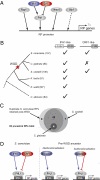Gene duplication and the evolution of ribosomal protein gene regulation in yeast
- PMID: 20212107
- PMCID: PMC2851827
- DOI: 10.1073/pnas.0911905107
Gene duplication and the evolution of ribosomal protein gene regulation in yeast
Abstract
Coexpression of genes within a functional module can be conserved at great evolutionary distances, whereas the associated regulatory mechanisms can substantially diverge. For example, ribosomal protein (RP) genes are tightly coexpressed in Saccharomyces cerevisiae, but the cis and trans factors associated with them are surprisingly diverged across Ascomycota fungi. Little is known, however, about the functional impact of such changes on actual expression levels or about the selective pressures that affect them. Here, we address this question in the context of the evolution of the regulation of RP gene expression by using a comparative genomics approach together with cross-species functional assays. We show that an activator (Ifh1) and a repressor (Crf1) that control RP gene regulation in normal and stress conditions in S. cerevisiae are derived from the duplication and subsequent specialization of a single ancestral protein. We provide evidence that this regulatory innovation coincides with the duplication of RP genes in a whole-genome duplication (WGD) event and may have been important for tighter control of higher levels of RP transcripts. We find that subsequent loss of the derived repressor led to the loss of a stress-dependent repression of RPs in the fungal pathogen Candida glabrata. Our comparative computational and experimental approach shows how gene duplication can constrain and drive regulatory evolution and provides a general strategy for reconstructing the evolutionary trajectory of gene regulation across species.
Conflict of interest statement
The authors declare no conflict of interest.
Figures



Similar articles
-
Role of CK2-dependent phosphorylation of Ifh1 and Crf1 in transcriptional regulation of ribosomal protein genes in Saccharomyces cerevisiae.Biochim Biophys Acta. 2016 Aug;1859(8):1004-13. doi: 10.1016/j.bbagrm.2016.06.003. Epub 2016 Jun 15. Biochim Biophys Acta. 2016. PMID: 27321754
-
Yap7 is a transcriptional repressor of nitric oxide oxidase in yeasts, which arose from neofunctionalization after whole genome duplication.Mol Microbiol. 2015 Jun;96(5):951-72. doi: 10.1111/mmi.12983. Epub 2015 Mar 28. Mol Microbiol. 2015. PMID: 25732006
-
Growth-regulated recruitment of the essential yeast ribosomal protein gene activator Ifh1.Nature. 2004 Dec 23;432(7020):1058-61. doi: 10.1038/nature03200. Nature. 2004. PMID: 15616569
-
Evolutionary relationships between Saccharomyces cerevisiae and other fungal species as determined from genome comparisons.Rev Iberoam Micol. 2005 Dec;22(4):217-22. doi: 10.1016/s1130-1406(05)70046-2. Rev Iberoam Micol. 2005. PMID: 16499414 Review.
-
Selection for more of the same product as a force to enhance concerted evolution of duplicated genes.Trends Genet. 2006 Dec;22(12):642-4. doi: 10.1016/j.tig.2006.09.014. Epub 2006 Oct 11. Trends Genet. 2006. PMID: 17045359 Review.
Cited by
-
A synergism between adaptive effects and evolvability drives whole genome duplication to fixation.PLoS Comput Biol. 2014 Apr 17;10(4):e1003547. doi: 10.1371/journal.pcbi.1003547. eCollection 2014 Apr. PLoS Comput Biol. 2014. PMID: 24743268 Free PMC article.
-
Promoter architectures in the yeast ribosomal expression program.Transcription. 2011 Mar;2(2):71-77. doi: 10.4161/trns.2.2.14486. Transcription. 2011. PMID: 21468232 Free PMC article.
-
Comparative Transcriptomics Highlights New Features of the Iron Starvation Response in the Human Pathogen Candida glabrata.Front Microbiol. 2018 Nov 16;9:2689. doi: 10.3389/fmicb.2018.02689. eCollection 2018. Front Microbiol. 2018. PMID: 30505294 Free PMC article.
-
Yeast: an experimental organism for 21st Century biology.Genetics. 2011 Nov;189(3):695-704. doi: 10.1534/genetics.111.130765. Genetics. 2011. PMID: 22084421 Free PMC article. Review.
-
Adaptation of cells to new environments.Wiley Interdiscip Rev Syst Biol Med. 2011 Sep-Oct;3(5):544-61. doi: 10.1002/wsbm.136. Epub 2010 Dec 31. Wiley Interdiscip Rev Syst Biol Med. 2011. PMID: 21197660 Free PMC article. Review.
References
-
- Tuch BB, Li H, Johnson AD. Evolution of eukaryotic transcription circuits. Science. 2008;319:1797–1799. - PubMed
Publication types
MeSH terms
Substances
Grants and funding
LinkOut - more resources
Full Text Sources
Other Literature Sources
Molecular Biology Databases

